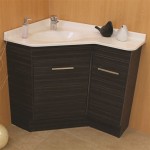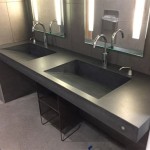How To Hang A Bathroom Sink On The Wall
Wall-mounted bathroom sinks offer a modern and space-saving alternative to traditional vanity-mounted sinks. They create an open and airy feel in the bathroom, making them a popular choice for smaller spaces or contemporary designs. Installing a wall-mounted sink requires careful planning and precise execution to ensure stability and proper plumbing connections. This article provides a comprehensive guide on how to hang a bathroom sink on the wall, covering essential steps from preparation to final installation.
Before commencing the installation process, it is crucial to gather the necessary tools and materials. These typically include: the wall-mounted sink itself, a suitable mounting bracket (often supplied with the sink), a level, a stud finder, a pencil, a drill with appropriate drill bits (including a masonry bit if working with tile or concrete), a wrench (or adjustable wrench), a pipe cutter, pipe joint compound or Teflon tape, supply lines, a P-trap, a drain tailpiece, safety glasses, and work gloves.
Furthermore, it's essential to understand the existing plumbing layout and ensure compatibility with the new sink's drain and supply line locations. Identifying the location of shut-off valves for both hot and cold water is paramount for safely disconnecting the existing water supply. If the existing plumbing needs modification, it may be necessary to consult with a qualified plumber to ensure compliance with local building codes. Thorough preparation minimizes potential complications and contributes to a successful installation.
Key Point 1: Identifying Wall Structure and Mounting Bracket Installation
The most critical aspect of installing a wall-mounted sink is ensuring a secure and stable mounting. The wall structure must be capable of supporting the weight of the sink, especially when filled with water. Ideally, the mounting bracket should be anchored directly to wall studs. A stud finder is used to locate these studs. If studs are not ideally positioned for the sink's desired location, a horizontal ledger board can be securely fastened to the studs, providing a wider and more adaptable mounting surface for the sink bracket.
If wall studs are not accessible or appropriately positioned, alternative anchoring methods must be considered. For concrete or brick walls, heavy-duty masonry anchors are required. These anchors typically involve drilling into the masonry and inserting expanding bolts that create a secure hold. For drywall installations without stud access, specialized drywall anchors designed to hold significant weight are necessary. However, drywall alone may not always provide sufficient support for heavier sinks, and reinforcing the wall internally might be required. This could involve opening the wall and installing additional studs or bracing.
Once the wall structure is identified and the anchoring method determined, precisely mark the location for the mounting bracket. Use a level to ensure the bracket is perfectly horizontal. Incorrectly positioned brackets will result in a crooked sink, affecting both aesthetics and functionality. Drill pilot holes at the marked locations. When drilling into tile, use a specialized tile drill bit and proceed slowly to prevent cracking the tile. Insert the appropriate anchors into the pilot holes. Secure the mounting bracket to the wall using screws or bolts appropriate for the chosen anchors. Test the bracket's stability by applying downward pressure. Any movement indicates inadequate anchoring and requires further reinforcement.
The type of mounting bracket will vary depending on the sink design. Some sinks use a single, centrally located bracket, while others utilize two brackets positioned on either side of the sink. Follow the manufacturer's instructions for the specific mounting bracket included with the sink. Ensure all screws or bolts are tightened securely, but avoid over-tightening, which could damage the wall or the bracket.
Key Point 2: Plumbing Connections and Drain Assembly
After the mounting bracket is securely installed, the next step involves connecting the plumbing. Begin by turning off the water supply to both the hot and cold water lines. This prevents flooding during the plumbing connection process. Disconnect the existing water supply lines from the old faucet or fixture. Place a bucket underneath the pipes to catch any residual water.
Inspect the existing shut-off valves for leaks or corrosion. If the valves are old or faulty, consider replacing them to prevent future problems. Install new supply lines that connect from the shut-off valves to the faucet connections on the wall-mounted sink. The length of the supply lines must be sufficient to reach the faucet without excessive bending or stretching. Use pipe joint compound or Teflon tape on the threaded connections to ensure a watertight seal. Tighten the connections using a wrench, but avoid over-tightening.
The drain assembly typically consists of a tailpiece, a P-trap, and a drain pipe that connects to the main drain line in the wall. The tailpiece is the vertical pipe that extends down from the sink drain. The P-trap is a U-shaped pipe that traps water, preventing sewer gases from entering the bathroom. The drain pipe connects the P-trap to the main drain line. Assemble the drain components according to the manufacturer's instructions.
Ensure all connections are properly tightened to prevent leaks. Use pipe joint compound or Teflon tape on threaded connections. The P-trap should be positioned correctly to ensure proper drainage. If the existing drain line is not aligned with the sink's drain location, it may be necessary to modify the drain pipe using extensions or adapters. This may require cutting and reassembling the drain pipe. A pipe cutter is used for making clean, precise cuts. After cutting, deburr the cut edges to prevent damage to the drain fittings.
Once the drain assembly is complete, carefully align the sink with the mounting bracket and slide it into place. Ensure the sink is securely seated on the bracket. Connect the tailpiece to the sink drain. Tighten the connection using a wrench, but avoid over-tightening. Inspect all plumbing connections for leaks. Turn on the water supply and check for leaks at the supply line connections and the drain assembly. If any leaks are detected, tighten the connections further or disassemble and reapply pipe joint compound or Teflon tape.
Key Point 3: Sink Placement and Final Adjustments
With the mounting bracket installed and the initial plumbing connections made, the sink can be placed onto the bracket. Carefully lift the sink and align it with the bracket, ensuring it sits flush against the wall. Sink designs vary, and some may require additional securing mechanisms, such as bolts or screws that attach the sink to the bracket. Consult the manufacturer's instructions for specific details.
After placing the sink, use a level to double-check its horizontal alignment. Minor adjustments can often be made by slightly loosening the mounting bracket screws and repositioning the bracket. Once the sink is level, securely tighten all screws and bolts. Wiggle the sink gently to ensure it is stable and does not move excessively. If any movement is detected, further reinforcement of the mounting bracket may be necessary.
Connect the faucet to the supply lines. Ensure the hot and cold water lines are connected to the appropriate faucet inlets. Tighten the connections using a wrench, but avoid over-tightening. Turn on the water supply slowly and check for leaks at the faucet connections. Operate the faucet to ensure proper water flow and drainage. Check for leaks around the sink drain and the P-trap. If any leaks are detected, tighten the connections further or disassemble and reapply pipe joint compound or Teflon tape.
Inspect all plumbing connections thoroughly for leaks or drips. Run water in the sink for several minutes to ensure the drain is functioning properly and there are no leaks under normal usage conditions. If any problems are identified, address them promptly to prevent water damage. Properly sealing around the sink where it meets the wall can prevent water from seeping behind the sink. Use a high-quality waterproof sealant, such as silicone caulk, to create a seal between the sink and the wall. Apply the sealant evenly and smoothly, and remove any excess with a damp cloth.
After the sealant has dried completely, the installation is complete. The wall-mounted sink should be securely attached to the wall, and all plumbing connections should be leak-free. This installation process requires careful attention to detail and adherence to safety precautions; however, with proper preparation and execution, a wall-mounted sink can provide both aesthetic appeal and functional benefits in the bathroom.
Pedestal And Wall Mount Bathroom Sinks

How To Install A Sink Wall Mount 3 Minute Guide

Installing A Bathroom Sink Wall Hung Diy Family Handyman

Bath How To Install A Wall Hung Basin

Fitting A Wall Hung Basin On Stud Bathroom Guru

Pros And Cons Of Wall Mount Faucets Hawaii Interior Designer Sachi Lord

Wall Mounted Bathroom Sinks Pros Cons Diy Install Guide

Here S How Install A Bathroom Pedestal Sink

How To Install A Wall Mount Bathroom Sink Hunker

Bath How To Install A Wall Hung Basin
Related Posts







